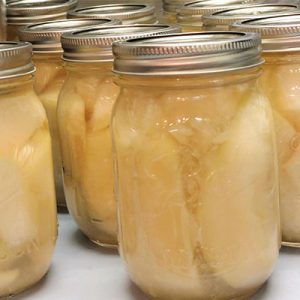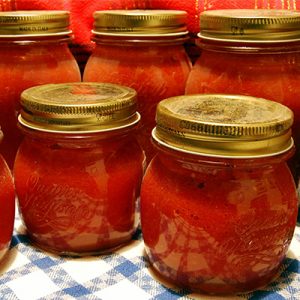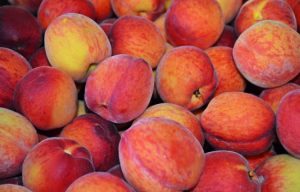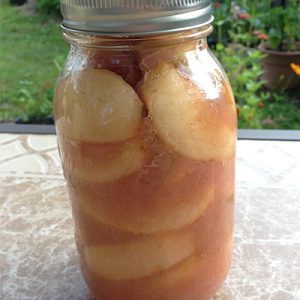Bulletin #4381, Canning Fruits and Tomatoes In a Boiling-Water-Bath Canner
Canning & Freezing Quick-Guides
Bulletin #4381, Canning Fruits and Tomatoes In a Boiling-Water-Bath Canner (PDF)

Prepared by Ann Hamilton, Food Safety Field Specialist, University of New Hampshire; reproduced with permission.
For information about UMaine Extension programs and resources, visit extension.umaine.edu.
Find more of our publications and books at extension.umaine.edu/publications/.
Acidified tomatoes and fruits are considered high acid foods and are safe to preserve using a boiling water canner. Boiling water canners work by transferring heat to the food by boiling water that surrounds the jars in the canner. Maintaining a temperature of 212 degrees Fahrenheit for the time specified in a tested recipe is adequate to destroy molds, yeasts, enzymes, and some bacteria. Processing times are usually given for altitudes under 1,000 feet above sea level. Higher altitudes need longer processing times. It is important to know your altitude before you start the canning process.
For more information on boiling water canning and specific processing times, download the publication Bulletin #4381, Canning Fruits & Tomatoes In a Boiling-Water-Bath Canner (PDF).
Visit the Elevation Map for Localities website for information on determining your altitude. Input your physical address and location to get your exact altitude.
Canning Fruits and Tomatoes In a Boiling Water Bath Canner
Boiling Water Processing
Heat is transferred to the food by boiling water that surrounds the jar in a boiling water bath canner. Maintaining a temperature of 212° F for the time specified in a tested recipe is adequate to destroy molds, yeasts, enzymes, and some bacteria. Processing times are usually given for altitudes under 1,000 feet above sea level. Higher altitudes need longer processing times.* It is important to know your altitude before you start the canning process.
General Directions
Follow directions for hot or raw pack and pack fruit or acidified tomatoes into hot jars. Leave ½ inch headspace except where indicated. Remove air bubbles. Wipe jar rims. Adjust lids. Process in a boiling water bath canner. Use a jar lifter to place and remove jars from the canner, being careful to not tilt the jars in the process.
Boiling Water Bath Procedure
Fill the canner about half full of water.
Preheat the water to 140°F for raw-packed foods and to 180°F for hot-packed foods.
While keeping the pre-filled jars upright, place them on a rack in the canner.
Add more hot water if necessary to cover the jars with at least 1 inch of water.
Place the lid on the canner and keep covered during the entire process.
Turn heat to its highest position until water boils vigorously; then lower the heat setting to maintain a gentle boil while processing for the recommended time.
After processing for the correct amount of time based on altitude, turn off the heat and remove the canner from the burner, remove the canner lid, and let the jars rest in the canner for 5 minutes before removing from the canner.
Anti-darkening Solution: Light-colored fruits such as apples and pears will turn dark once cut or peeled. To prevent darkening, hold small batches of fruit in ascorbic acid (Vitamin C) solution until ready to use. Mix one teaspoon or 3000 mg of ascorbic acid in one gallon of water. Commercially prepared mixes of ascorbic are also available where canning supplies are sold. Follow the manufacturer’s directions. Drain thoroughly before canning.
*Altitude Adjustment: For altitudes of 1,001-3,000 ft. add 5 minutes to processing time.
Apples, sliced
- Preparation: Wash, peel, core, and slice into ½ inch wedges. Place into anti-darkening solution. Drain slices.
- Hot pack: Put 5 lbs. of slices in a pot with 2 cups of water, very light, light or medium syrup. Boil 5 minutes. Fill jars with hot slices and hot syrup or hot water.
- Jar size: Pint or Quarts
- Processing Time in Boiling Water Canner (0 – 1000 ft*) : 20 Minutes
Applesauce
- Preparation: Wash, peel, core. Slice and place into anti-darkening solution. Drain slices.
- Hot pack: Place sliced apples in a large pot, add ½ cup water. Heat until tender. Press through a sieve for a smooth sauce. Add sugar if desired – 1/8 cup per quart or to taste. Reheat to boiling, fill hot jars with hot apple sauce.
- Jar size: Pints or Quarts
- Processing Time in Boiling Water Canner (0 – 1000 ft*): 15 Minutes, 20 Minutes
Berries (whole blackberries, blueberries, raspberries)
- Preparation: Wash. Drain, cap, stem.
- Hot pack: Blanch 1 pound of berries in 1 gallon boiling water for 30 seconds, drain. Add ½ cup hot syrup, juice or water to hot jars. Pack hot berries into hot jars. Fill with more hot liquid.
- Jar size: Pints or Quarts
- Processing Time in Boiling Water Canner (0 – 1000 ft*): 15 minutes
Fruit Purees of any fruit except bananas, Asian pears, figs, tomatoes, melons, papaya, ripe mango or coconut
- Preparation: Stem, wash, drain, peel and remove pits.
- Hot pack: Measure fruit into a large pot, crushing slightly if desired. Add 1 cup hot water for each quart of fruit. Cook slowly until soft. Stir frequently. Press through sieve or food mill. If desired, add sugar to taste. Reheat until sugar dissolves. Fill hot puree into hot jars. Leave ¼ inch headspace.
- Jar size: Pints or Quarts
- Processing Time in Boiling Water Canner (0 – 1000 ft*): 15 minutes
Peaches, Apricots, Nectarines
- Preparation: To remove skins from peaches, dip in boiling water for 30-60 seconds until skins loosen. Dip in cold water. Slip off skins. Cut in half, remove pit and slice if desired. Skin removal is optional for apricots. Don’t remove nectarine skins. Place into anti-darkening solution. Drain.
- Hot pack: Place in boiling juice, water or syrup, bring to boil. Fill hot jars with hot fruit. Place halves in layers cut side down. Fill with hot liquid.
- Raw pack: Fill hot jars with raw fruit cut side down for halves. Fill with hot liquid.
- Jar size: Pints or Quarts
- Processing Time in Boiling Water Canner (0 – 1000 ft*): Hot pack 20 minutes, 25 minutes; raw pack: 25 minutes, 30 minutes
Pears, Halved
 Preparation: Wash, peel. Cut lengthwise in half, remove the core. Place into anti-darkening solution. Drain.
Preparation: Wash, peel. Cut lengthwise in half, remove the core. Place into anti-darkening solution. Drain.- Hot pack: Boil pears 5 minutes in syrup, juice or water. Fill hot jars with hot fruit. Fill with hot liquid.
- Jar size: Pints or Quarts
- Processing Time in Boiling Water Canner (0 – 1000 ft*): 20 minutes, 25 minutes
Plums, halved or whole
- Preparation: Wash. To can whole, prick the skin on two sides with a fork. Freestone varieties may be halved and pitted.
- Hot pack: Add plums to hot water or very light, light or medium syrup. Boil 2 minutes, cover saucepan, let stand 20-30 minutes. Fill hot jars with hot fruit and cooking liquid or syrup.
- Raw pack: Fill hot jars with raw plums, pack firmly. Fill with hot water or syrup.
Jar size: Pints or Quarts - Processing Time in Boiling Water Canner (0 – 1000 ft*): 20 minutes, 25 minutes
Rhubarb, Stewed
- Preparation: Select young, tender stalks. Trim off leaves. Wash, cut stalks into ½ to 1” pieces.
- Hot pack: Add ½ cup sugar to each quart rhubarb and let stand until juice appears. Gently bring to a boil. Fill hot jars immediately.
- Jar size: Pints or Quarts
- Processing Time in Boiling Water Canner (0 – 1000 ft*): 15 minutes
Tomatoes, crushed (with no added liquid)
- Preparation: Wash tomatoes. Dip in boiling water 30-60 seconds or until skins split. Dip in cold water. Remove skins, core. Quarter.
- Hot pack: Heat about 1 pound of the quarters quickly in a large pot, crushing them with a spoon as they’re added to the pot. Continue heating. Stir. Once boiling, gradually add remaining tomatoes, stir constantly. Remaining tomatoes don’t need to be crushed. Boil gently 5 minutes. Add 2 tablespoons of bottled lemon juice OR ½ teaspoon citric acid to each quart jar (1 tablespoon bottled lemon juice or ¼ teaspoon citric acid to each pint). Fill hot jars with hot tomatoes. Add ½ teaspoon salt to each pint jar (1 teaspoon/quart) if desired.
- Jar size: Pint or Quarts
- Processing Time in Boiling Water Canner (0 – 1000 ft*): 35 minutes, 45 minutes
Tomatoes, whole or halved (packed in water)
 Preparation: Prepare tomatoes as above. Leave whole or halve.
Preparation: Prepare tomatoes as above. Leave whole or halve.- Hot pack: Place in pot, cover with water, boil gently for 5 minutes. Add bottled lemon juice or citric acid to jars (see above). Fill hot jars with hot tomatoes. Fill jars with hot cooking liquid. Add ½ teaspoon salt to each pint jar (1 teaspoon/quart) if desired.
- Raw pack: Add bottled lemon juice or citric acid to jars (see above). Add ½ teaspoon salt to each pint jar (1 teaspoon/quart) if desired. Pack prepared tomatoes into hot jars. Fill jars with boiling water.
- Jar size: Pint or Quarts.
- Processing Time in Boiling Water Canner (0 – 1000 ft*): 40 minutes, 4
Did You Know?
Tomatoes have a pH value that falls close to 4.6. To ensure safe acidity levels in whole, crushed, or juiced tomatoes; add lemon juice or citric acid according to directions, whether they will be processed in boiling water or pressure canner.
For More Information
For more information on food preservation, go to the National Center for Home Food Preservation Website.
New Hampshire Extension
State Office
Taylor Hall
59 College Rd.
Durham, NH 03824
Education Center and Information Line
answers@unh.edu
1.877.EXT.GROW (1.877.398.4769)
9:00 a.m.–2:00 p.m., Monday-Friday
Information in this publication is provided purely for educational purposes. No responsibility is assumed for any problems associated with the use of products or services mentioned. No endorsement of products or companies is intended, nor is criticism of unnamed products or companies implied.
© 2007, 2009, 2019
Call 800.287.0274 (in Maine), or 207.581.3188, for information on publications and program offerings from University of Maine Cooperative Extension, or visit extension.umaine.edu.
In complying with the letter and spirit of applicable laws and pursuing its own goals of diversity, the University of Maine System does not discriminate on the grounds of race, color, religion, sex, sexual orientation, transgender status, gender, gender identity or expression, ethnicity, national origin, citizenship status, familial status, ancestry, age, disability physical or mental, genetic information, or veterans or military status in employment, education, and all other programs and activities. The University provides reasonable accommodations to qualified individuals with disabilities upon request. The following person has been designated to handle inquiries regarding non-discrimination policies: Director of Equal Opportunity and Title IX Services, 5713 Chadbourne Hall, Room 412, University of Maine, Orono, ME 04469-5713, 207.581.1226, TTY 711 (Maine Relay System).



